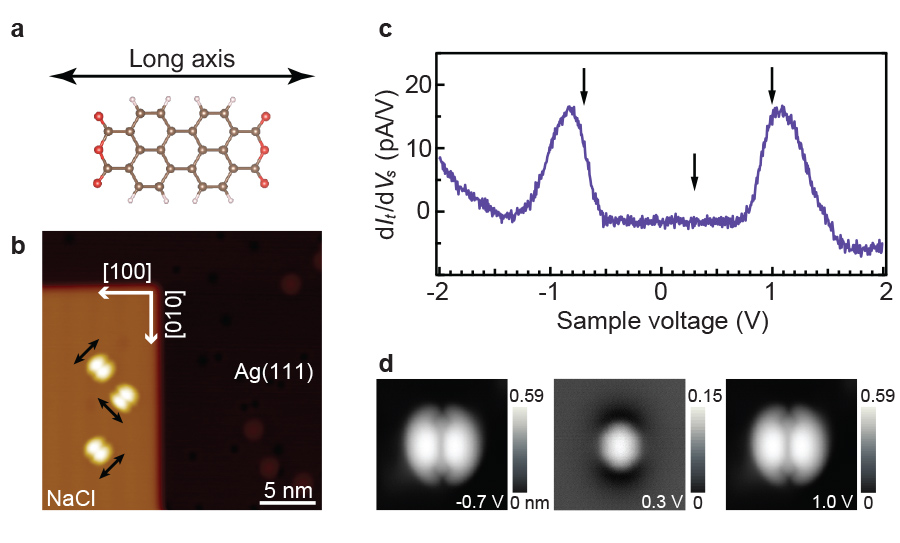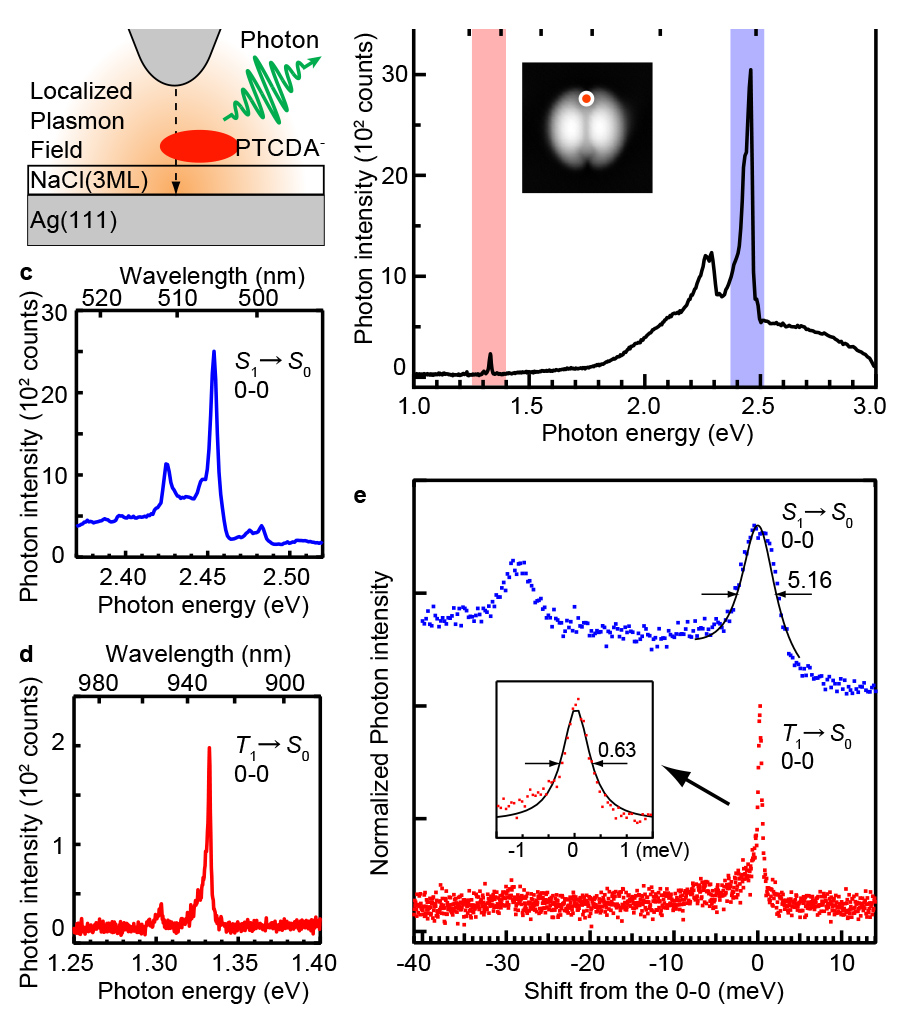Chemists Manipulate the Physics of Digital Devices
Researchers lower voltage of electrical current to boost energy efficiency
Published Date
By:
- Cynthia Dillon
Share This:
Article Content
Having powerful but highly efficient smartphones, laptops and TVs would be satisfying to many digital device users—including plugged-in scientists like those from the University of California San Diego and Japan’s RIKEN Cluster for Pioneering Research (RIKEN). Together, they collaborated with international partners to discover how to significantly reduce the amount of energy required by OLEDs. These are organic light emitting diodes that brighten when fed with electricity. They’ve attracted attention as potential replacements for liquid crystal diodes, or LEDs, currently the displays of choice, since they offer advantages such as being flexible, thin and require no backlighting.

Fig.1: STM measurements of the PCTDA/NaCl(3ML)/Ag(111) junction: (a) PCTDA molecular structure; (b) and (d) STM images of the molecule; (c) conductance characteristic of the junction. Figure courtesy of Michael Galperin
The scientists, whose research findings are published in Nature, developed a new way to manipulate the “excitons”—pairs of electrons and electron holes—that transport excitation within OLEDs. Essentially, electrical current passing through a device creates electron-hole pairs, and when they recombine, they emit visible light in the process. Normally, the excitons in OLEDs arise in two patterns: singlets and triplets. Due to exchange interaction the singlets, which are created along with the triplets, require more energy. And though they can be converted into triplets, it still means that the device as a whole requires the energy to create them in the first place.
In their work, the scientists, including UC San Diego Chemist Michael Galperin found a way to induce formation of triplets only. This allowed for a reduction of the operation voltage, thus increasing the energy efficiency of OLEDs. Beginning with fundamental research to understand the basic physics behind the creation of excitons, the scientists used precise single-molecule electroluminescence measurements with a scanning tunneling microscope (STM) combined with an optical detection system. They prepared a model system based on an isolated molecule of perylenetetracarboxylic dianhydride (PTCDA), an organic semiconductor, adsorbed on a metal-supported ultrathin insulating film. Next, they used a special technique to impart a negative charge to the molecule. Then, they used the current from a STM to induce luminescence in the molecule, and monitored what type of exciton was created based on the emission spectrum.
The measurements showed that at low voltage, only triplets were formed. Theoretical calculations by Galperin and Kuniyuki Miwa, a former UC San Diego postdoctoral scholar in the Galperin Research Group, confirmed the experimental results and suggested the mechanism.
“Theoretically, the motivation was to perform rigorous quantitative analysis of the experimental data while demonstrating capabilities of a new technique—the Hubbard nonequilibrium Green’s function method—developed in my group,” said Galperin. “The method was developed with exactly this kind of problem—the single molecule optoelectronic devices—in mind. Contrary to existing methodologies, it can accurately predict responses (current and luminescence) of devices to external perturbations.”
Galperin said that the researchers were surprised by their observation of significant luminescence signals, both fluorescence and phosphorescence. The observed enhancement was due to exciton interaction with the localized plasmon.

Fig.2: STL fluorescence and phosphorescence of the PCTDA/NaCl(3ML)/Ag(111) junction: (a) Luminescence scheme; (b) STL spectrum showing fluorescence (blue region - detailed spectrum in c) and phosphorescence (red region - detailed spectrum in d); (e) STL peak widths for singlet-singlet (blue) and triplet-singlet (red) transitions. Figure courtesy of Michael Galperin
“We believe that we were able to do this thanks to a previously unknown mechanism, where electrons are selectively removed from the charged molecule depending on their spin state,” said RIKEN’s Kensuke Kimura.
Yousoo Kim, leader of the Surface and Interface Science Laboratory at RIKEN, said that the findings could become a general working principle for novel OLEDs with low operating voltage.
This experimental work was supported by KAKENHI (grant nos. JP15H02025, JP21225001, JP18J11856, JP17H04796, JP17H05470, JP17K18766, JP26886013, JP16K21623) of the Ministry of Education, Culture, Sports, Science and Technology (MEXT) of Japan; MEXT/JSPS Fellowships (nos. JP18J11856, JP15J03915) and the RIKEN Junior Research Associate Program. Theoretical research was supported by the U.S. Department of Energy (grant no. DE-SC0018201).
The Department of Chemistry and Biochemistry at UC San Diego is ranked among the top 20 graduate programs in the nation.Share This:
You May Also Like
UC San Diego is Strengthening U.S. Semiconductor Innovation and Workforce Development
Technology & EngineeringStay in the Know
Keep up with all the latest from UC San Diego. Subscribe to the newsletter today.



